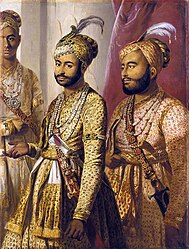File:Arcotprinces.jpg

Original file (682 × 900 pixels, file size: 200 KB, MIME type: image/jpeg)
| This is a file from the Wikimedia Commons. Information from its description page there is shown below. Commons is a freely licensed media file repository. You can help. |
Summary
| Tilly Kettle: Arcot princes
|
||||||||||||||||||||||
|---|---|---|---|---|---|---|---|---|---|---|---|---|---|---|---|---|---|---|---|---|---|---|
| Artist |
artist QS:P170,Q7802903 |
|||||||||||||||||||||
| Title |
Arcot princes label QS:Len,"Arcot princes" |
|||||||||||||||||||||
| Object type |
painting object_type QS:P31,Q3305213 |
|||||||||||||||||||||
| Description |
English: A few princes, like these sons of the Nawab of Arcot, were painted by the popular artist Tilly Kettle (c.1770)
Source: http://search.sothebys.com/jsps/live/lot/LotDetail.jsp?lot_id=4FGKN (downloaded May 2005) "A PORTRAIT OF UMDAT AL-UMARA AND AMIR AL-UMARA, SONS OF NAWAB MUHAMMAD ALI KHAN OF ARCOT AND THE CARNATIC, TILLY KETTLE (1734/5-1786), ENGLISH SCHOOL, INDIA, CIRCA 1770; 127 by 96.5cm.; oil on canvas.
|
|||||||||||||||||||||
| Date |
1770 date QS:P571,+1770-00-00T00:00:00Z/9 |
|||||||||||||||||||||
| Medium |
oil on canvas medium QS:P186,Q296955;P186,Q12321255,P518,Q861259 |
|||||||||||||||||||||
| Dimensions | 127 by 96.5 cm | |||||||||||||||||||||
| Object history |
|
|||||||||||||||||||||
| Source/Photographer | http://www.columbia.edu/itc/mealac/pritchett/00routesdata/1700_1799/localrulers/arcot/arcot.html | |||||||||||||||||||||
| Other versions |
 |
|||||||||||||||||||||
Licensing
|
This is a faithful photographic reproduction of a two-dimensional, public domain work of art. The work of art itself is in the public domain for the following reason:
The official position taken by the Wikimedia Foundation is that "faithful reproductions of two-dimensional public domain works of art are public domain".
This photographic reproduction is therefore also considered to be in the public domain in the United States. In other jurisdictions, re-use of this content may be restricted; see Reuse of PD-Art photographs for details. | |||||
Captions
Items portrayed in this file
depicts
1770
image/jpeg
e8c793d1a412758a3c762bbf2f953bb90fd80dfc
204,305 byte
900 pixel
682 pixel
File history
Click on a date/time to view the file as it appeared at that time.
| Date/Time | Thumbnail | Dimensions | User | Comment | |
|---|---|---|---|---|---|
| current | 09:47, 18 June 2012 |  | 682 × 900 (200 KB) | Napoleon 100 | better |
| 06:56, 16 June 2012 |  | 682 × 900 (163 KB) | Napoleon 100 |
File usage
The following 2 pages use this file:
Global file usage
The following other wikis use this file:
- Usage on hi.wikipedia.org
- Usage on www.wikidata.org
Metadata
This file contains additional information, probably added from the digital camera or scanner used to create or digitize it.
If the file has been modified from its original state, some details may not fully reflect the modified file.
| Width | 682 px |
|---|---|
| Height | 900 px |
| Bits per component |
|
| Pixel composition | RGB |
| Orientation | Normal |
| Number of components | 3 |
| Horizontal resolution | 72 dpi |
| Vertical resolution | 72 dpi |
| Software used | Adobe Photoshop CS5.1 Windows |
| File change date and time | 15:16, 18 June 2012 |
| Exif version | 2.21 |
| Color space | sRGB |
| Unique ID of original document | adobe:docid:photoshop:df25943e-b998-11d9-b6f1-e8ebce24ce4e |
| Date and time of digitizing | 20:46, 18 June 2012 |
| Date metadata was last modified | 20:46, 18 June 2012 |
| Copyright status | Copyright status not set |
| IIM version | 48,670 |


